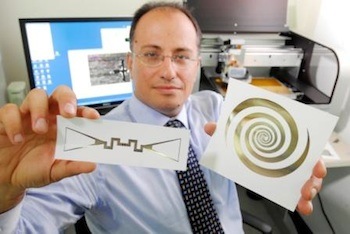RF harvesting could pluck energy from the air
Jul 13, 2011 — by LinuxDevices Staff — from the LinuxDevices Archive — 2 viewsRadio-frequency energy from television, AM, FM, cellular, Wi-Fi, WiMAX, and other broadcasts can now be harvested to power electronic devices, researchers at the Georgia Institute of Technology have claimed. It's said applications could include security, environmental sensing, structural monitoring, and bio-monitoring devices.
Much has been made of the radio-frequency (RF) waves saturating every cubic inch of air in developed nations, and especially in metropolitan centers — where television, AM, FM, cellular, Wi-Fi, WiMAX, and scientific/medical sub-bands compete. One research group at the Atlanta-based Georgia Institute of Technology, however, sees RF saturation not as a potential health problem, but as an opportunity to scavenge power directly from the air.
According to the researchers, harvesting RF energy from the air and converting it into usable power for smarter electronic devices could enable:
- always-on security devices that work even during power outages
- environmental and structural sensors that do not require batteries
- food-preparation sensors that monitor spoilage inside containers
- and wearable biological sensors that can transmit vital signs to emergency responders even when the person wearing them is unconscious.

Georgia Tech professor Manos Tentzeris holds a sensor (left) and an ultra-broadband spiral antenna for wearable energy-scavenging applications, both of which were inkjet printed on paper
(Source: Georgia Tech)
Other groups have demonstrated the ability to harvest ambient RF power using relatively expensive antennas tuned to specific frequencies, but Georgia Tech researchers now claim to have created a cheap ultra-wideband antenna technology that can scavenge a wide swath of frequencies simultaneously and allows their energy-harvesting devices to generate much more power than earlier attempts.
"Using an ultra-wideband antenna that lets us exploit a variety of signals in different frequency ranges is giving us greatly increased power-gathering capability," said Manos Tentzeris, a professor at Georgia Tech.
Since 2006, Tentzeris and colleagues have been experimenting with antenna-based energy-scavenging devices, but only in relatively narrow bands. Now, the team claims to have created ultra-wideband antennas and sensors that can be printed on paper or clear polymers using conductive inks with embedded silver nanoparticles, making their energy-harvesting technology commercially feasible.
In demonstrations, Tentzeris' team has created self-powered sensors for chemical, biological, heat and stress applications. The team has also created ultra-cheap RFID (radio-frequency identification) tags using their techniques, which could be used in manufacturing, shipping, and for monitoring communications and power usage.
The system works by first converting alternating RF signals into direct current that charges either a super-capacitor or a battery, which typically saves up enough energy to power on a device. Only microWatts of power can be generated in real time from a single RF frequency, but the new ultra-wideband antennas mean milliwatts of power can be produced, enabling some low-power devices to be run directly. Eventually, the team hopes to power devices requiring as much as 50 milliwatts.
Funding for the research was provided by the National Science Foundation, the Federal Highway Administration, and Japan's New Energy and Industrial Technology Development Organization.
Further information
A presentation on the energy-scavenging technology was given July 6 at the IEEE Antennas and Propagation Symposium in Spokane, Wash. More information may be found on the Georgia Tech website.
R. Colin Johnson wrote this article for our sister publication SmarterTechnology.com.
This article was originally published on LinuxDevices.com and has been donated to the open source community by QuinStreet Inc. Please visit LinuxToday.com for up-to-date news and articles about Linux and open source.